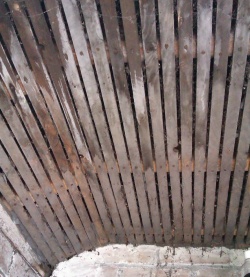Difference between revisions of "Lath & plaster ceiling"
(Created page with "right|250px|Laths before plastering '''Lath & plaster''' walls & ceilings are often found in old houses. They consist of 2 parts: # Laths, ...") |
|||
| Line 21: | Line 21: | ||
==Overboarding== | ==Overboarding== | ||
| − | Putting plasterboard over (or technically under) old L&P is another repair option. The sound retaining property of L&P is retained, and the filth from hell is avoided. But locating joists for the new screws can be rather hit & miss. If you can lift a few floorboards above, drilling some tiny marker holes next to joists can be a real help; joist positions can then be pencilled onto the ceiling or the top of the [[ | + | Putting plasterboard over (or technically under) old L&P is another repair option. The sound retaining property of L&P is retained, and the filth from hell is avoided. But locating joists for the new screws can be rather hit & miss. If you can lift a few floorboards above, drilling some tiny marker holes next to joists can be a real help; joist positions can then be pencilled onto the ceiling or the top of the [[wall]]s. |
| − | + | ==See also== | |
Revision as of 06:27, 1 October 2014
Lath & plaster walls & ceilings are often found in old houses. They consist of 2 parts:
- Laths, thin wood strips nailed to the joists or uprights, with gaps between them
- Plaster, pressed on so it squeezes through the gaps and grips the laths
Historic L&P ceilings use wood laths & lime plaster. Modern L&P is seen occasionally, typically with galvanised metal EML and gypsum plaster.
Properties
Old L&P ceilings contain much more plaster than plasterboard, giving much better noise blocking. The thicker plaster also improves fire resistance some.
Historic L&P is often in poor condition. If a lump drops down it can cause cuts requiring hospital cleanup and gluing or stitching.
Repair
Where its wished to retain an L&P ceiling that's beginning to break, screws & penny washers can be placed into joists to hold pieces up. Don't attempt to screw into lath, its a futile exercise. Pouring diluted PVA or fresh plaster onto the topside of the ceiling is done sometimes to stabilise old ceilings. Missing patches are fairly straightforward to patch with plaster. Once stabilised, a damaged ceiling can be skimmed, or in some cases patch filled.
Removal
When L&P begins to collapse its usually removed. Though simple to do (whack it), the normal result is filth so severe that it ruins the finish on everything it touches. Once gone, either the numerous nails are removed & new plasterboard is applied, or loose laths are refixed and the whole wet plastered.
Replacing L&P with plasterboard significantly increases sound transmission from room to room.
Overboarding
Putting plasterboard over (or technically under) old L&P is another repair option. The sound retaining property of L&P is retained, and the filth from hell is avoided. But locating joists for the new screws can be rather hit & miss. If you can lift a few floorboards above, drilling some tiny marker holes next to joists can be a real help; joist positions can then be pencilled onto the ceiling or the top of the walls.
